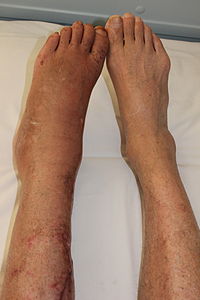
Photo from wikipedia
A serious consequence of ischemia-reperfusion injury (I/R) is oxidative damage leading to mitochondrial dysfunction. Such I/R-induced mitochondrial dysfunction is observed as impaired state 3 respiration, decreased ATP generation, and overproduction… Click to show full abstract
A serious consequence of ischemia-reperfusion injury (I/R) is oxidative damage leading to mitochondrial dysfunction. Such I/R-induced mitochondrial dysfunction is observed as impaired state 3 respiration, decreased ATP generation, and overproduction of O2. The cascading ROS can propagate cysteine oxidation on mitochondrial complex I and add insult to myocardial injury. Herein we employed LC-MS/MS to identify protein cysteine oxidation of complex I in the mitochondria of sham control rat hearts and I/R mitochondria from the infarct region of rat hearts subjected to 30 min of coronary ligation and 24h of reperfusion in vivo. Mitochondrial preparations from infarct regions had significantly enhanced S-sulfonation (C-SO3) levels on the cysteine ligands of iron-sulfur clusters, including N3 (C425), N1b (C92), N4 (C226), N2 (C158/C188), and N1a (C134/C139). The 4Fe-4S centers of N3, N1b, N4, and N2 are key redox-active components of complex I, thus C-SO of metal-binding sites impaired the main electron transfer pathway. The binuclear N1a has a very low redox potential and functions as temporary storage for electrons and antioxidants. Increased C134/C139 C-SO by I/R impaired the cluster N1a, increasing O2 generation by complex I via FMNH∙ autooxidation. LC-MS/MS analysis also revealed I/R-mediated increased C-SO of regulatory thiols at the core subunits of Ndufv1 (C125, C142, C187, C206, C238, C255, C286), Ndus1 (C367, C554, C564, C727), and Ndufs2 (C146, C326, C347). These results were consistent with the consensus indicating that Ndufv1 and Ndus1 are two major polypeptides hosting regulatory thiols, and their enhanced C-SO by I/R predisposed the post-ischemic myocardium to have a more oxidized physiological setting. LC-MS/MS analysis further showed I/R-mediated enhanced C-SO at the supernumerary subunits of Ndufa10 (C67, C112, C183, C253), Ndufs5 (C43), and Ndufs6 (C79). The Ndufa10 subunit (42 kDa) is metazoan-specific, and loosely bound to complex I with a functional implication of stabilizing mammalian complex I. I/R-mediated enhanced C-SO of Ndufs10 weakens docking Ndufa10 subunit to the ND2 subunit, and destabilizes the structure of complex I. The Ndufs5 subunit (15 kDa) is confined to the face of intermembrane space. C43 of Ndufs5 is involved in twin CX9C motifs (C33/C43 and C56/C66), and forms an intramolecular disulfide bond with C56, which is functionally important for complex I stability. I/R-mediated C43 C-SO thus destabilized complex I; it is a consequence of reductively breaking the disulfide bond by ischemia followed by reperfusion-induced cysteine oxidation. C79 of Ndufs6 is involved in Zn2+-binding, which is functionally important for complex I assembly. C79 C-SO by I/R impaired Zn2+-binding, thus blocking a late step of complex I assembly and biogenesis. In conclusion, protein sulfonation of specific cysteines of complex I mediates I/R-induced mitochondrial dysfunction via impaired ETC activity, increases O2 production and pro-oxidant activity, and impairs the stability, assembly, and biogenesis of mammalian complex I.
Journal Title: Free Radical Biology and Medicine
Year Published: 2017
Link to full text (if available)
Share on Social Media: Sign Up to like & get
recommendations!